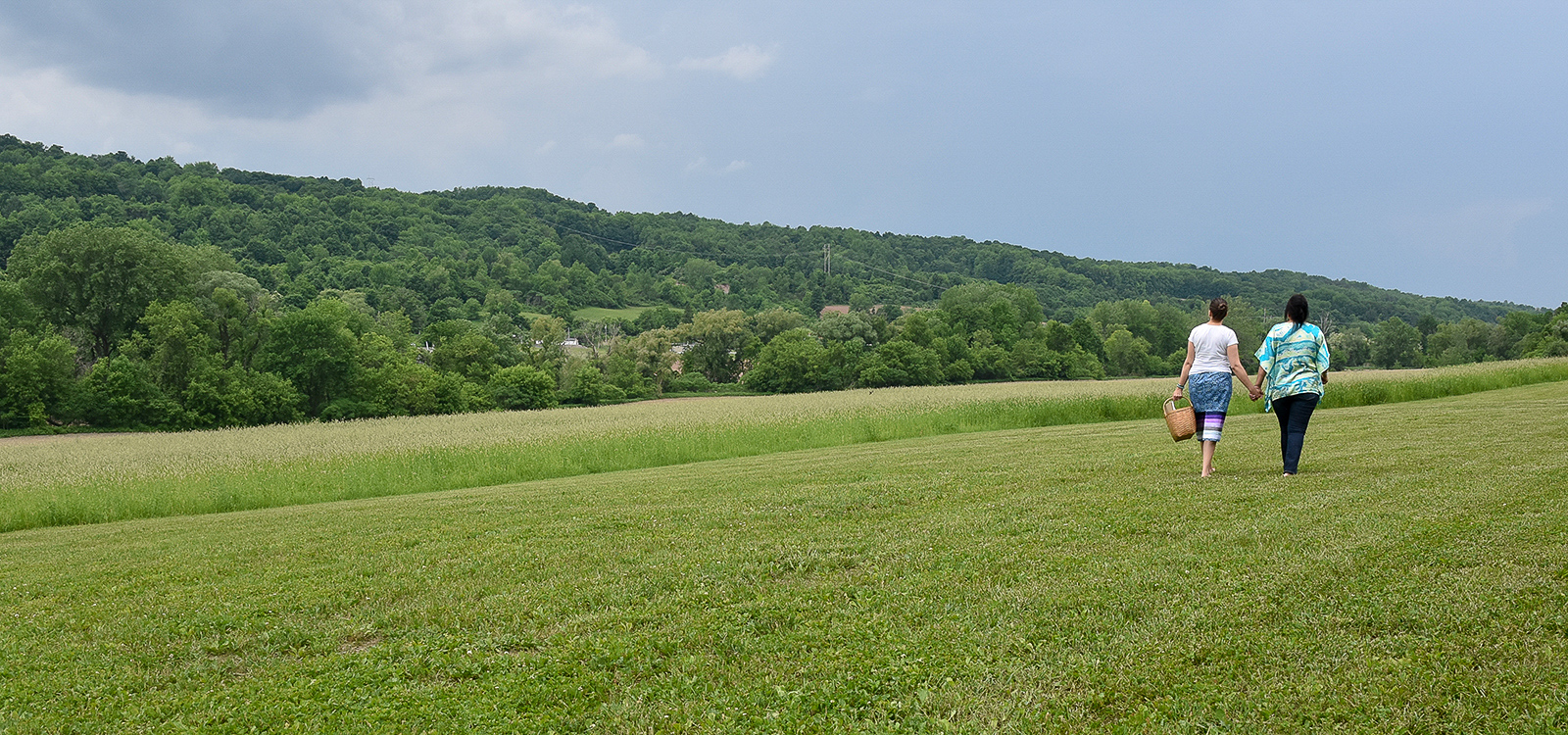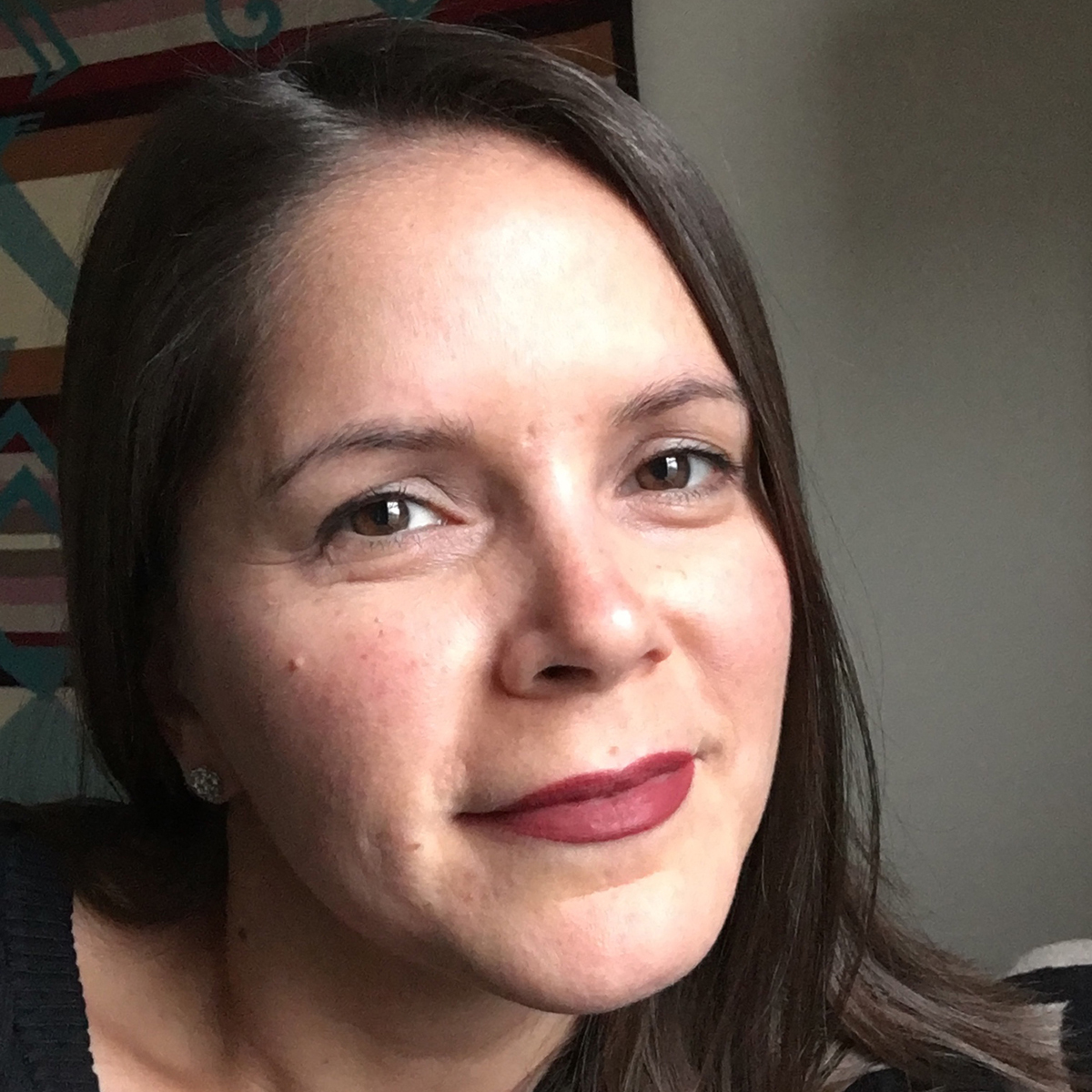An Indigenous Woman’s Guide to Upstate New York
I tried to shake my frustration and regroup, but my stomach turned. I took a deep breath and walked away. I then added calling the New York State agency responsible for this sign to my mental list of a lifetime’s worth of to-do’s, of correcting the stories told about my people. I can’t even drive past a local pub in Upstate New York without seeing little things — like a beer tap made in the form of a lacrosse stick for a brew called Wooden Stick — that offend me, romanticize and disrespect my culture and the history of my people. Of course, I expected moments like this on the journey I created to relax and reconnect to the lands critical to who I am and what I do. I needed this reconnection. A divine accident in the form of a car wreck and a traumatic brain injury prompted me to leave my law and business-consulting work and changed the direction of my life. To create a different path, I began working with my Indigenous sisters from across our Haudenosaunee Confederacy. Through gatherings focused on healing and sharing stories, we began to undo traumas left by the scars of colonization.
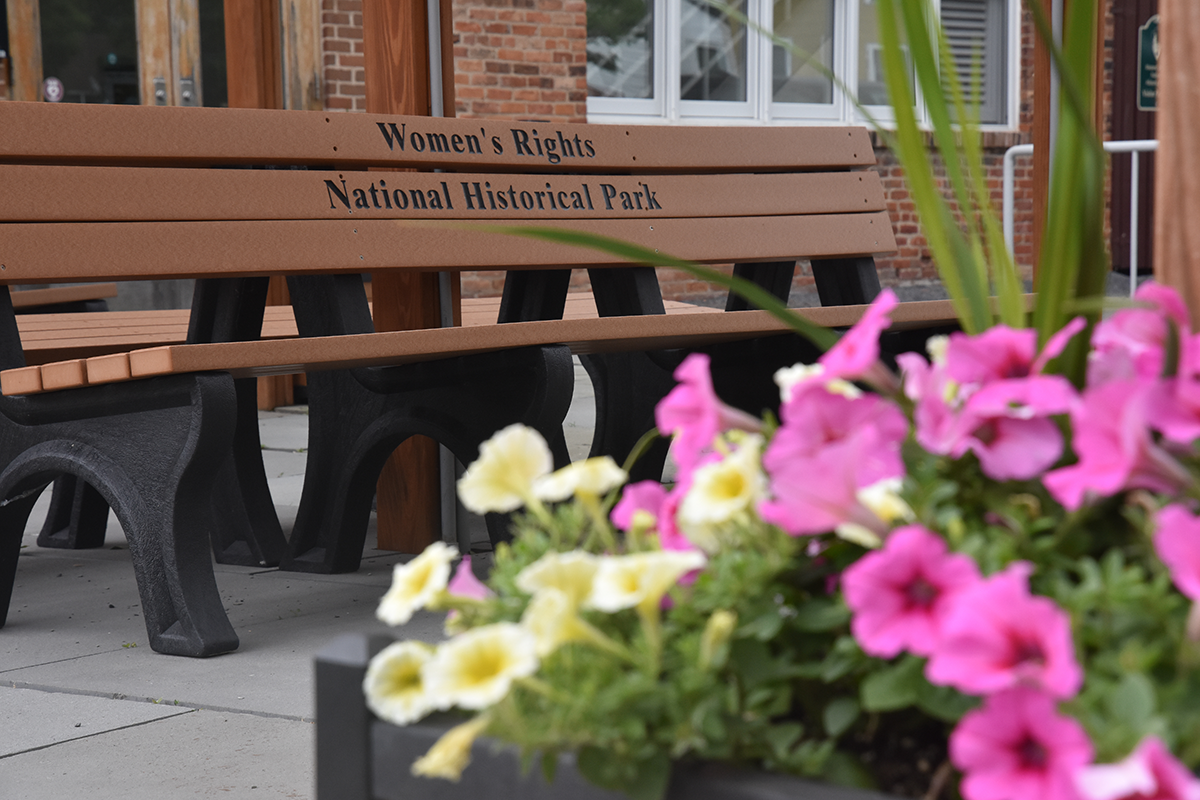
Seneca Falls, N.Y. is famous for being the birthplace of the women’s rights movement. The women involved in the movement were greatly influenced by the vital role women in the Haudenosaunee Confederacy played. Photo by Marita Pérez Díaz.
Those conversations and that work ignited a desire to spend a few days reconnecting with places we consider important. I dug deep and decided to pull out my inner Alicia Keys, ditching makeup for this journey. I wanted to feel as natural as possible and as close to nature and myself. I also rounded up my arsenal of colorful ribbon skirts. Skirts and dresses have always been a part of our traditional regalia. But handmade cotton calico and floral prints with multi-layered, bright silk ribbons sewn across the bottom serve as a critical part of a movement by Indigenous women. Across Turtle Island, what we call the lands in North America, we are reclaiming space and our identity as leaders in our nations, of our children, the land, and the water. Women are life givers, and our skirts connect the energy of our womb to the energy of the womb of Mother Earth, like an umbilical cord. The earth is the womb we are born from and to which we will one day return.
The night before I left on this journey, sleep eluded me. I wondered if I made the right choice to share this experience with others. As Indigenous people, we’ve become close with our culture because of the exploitation we experienced by settlers in the past. But I hear our Mother Earth screaming for the human conscience to wake up. As I started to fall asleep, a white buffalo came into my vision. The white buffalo is featured in a prophecy of the Lakota people: When a white buffalo is born, harmony will be restored to the world, but humans would need to make choices about how they lived. In my near-sleep state, I felt as if the white buffalo was nudging me, telling me to go forward. I understood this trip was the right thing to do.
As Indigenous people, we’ve become close with our culture because of the exploitation we experienced by settlers in the past.
The next morning, I grabbed my basket filled with tobacco, an eagle feather, a bullhorn rattle, an abalone shell, sage, corn, and some wampum. Rushing down the county roads that paved over ancient trails my people used to travel between the Mohawk, Oneida, Onondaga, Cayuga, Seneca, and Tuscarora nations, I drove to the casino spa that my nation owns. To my left, across the hilltop, I saw Oneida Lake as I left the lands of the Onondagas and entered my people’s territories. In other parts of the world, leaving one nation and entering another like this requires a passport, I thought as I drove.
I was running late. I pressed the gas pedal further to the floor. I wanted to begin my journey by decompressing. I picked Skana Spa (skana means peace in my language), which Forbes magazine gave a four-star rating. To get to the spa, I entered a hallway that features a small waterfall surrounded by succulents, with tall, glass walls looking out onto manicured streams and ornamental grasses that surrounded the building. In fact, large glass walls overlooked scenes of nature throughout the spa. Soft shades of light green and brown covered the walls, and tree beams supported a wooden, arched ceiling, resembling the inside of our traditional longhouses. I felt a sense of pride that my people own this. Our people struggled with poverty as we recovered from everything being taken from us in the name of U.S. progress — even our culture and language were ripped away. I descended into the lower level through a spiral staircase to the women’s spa. Herbal aromas drifted through the air.
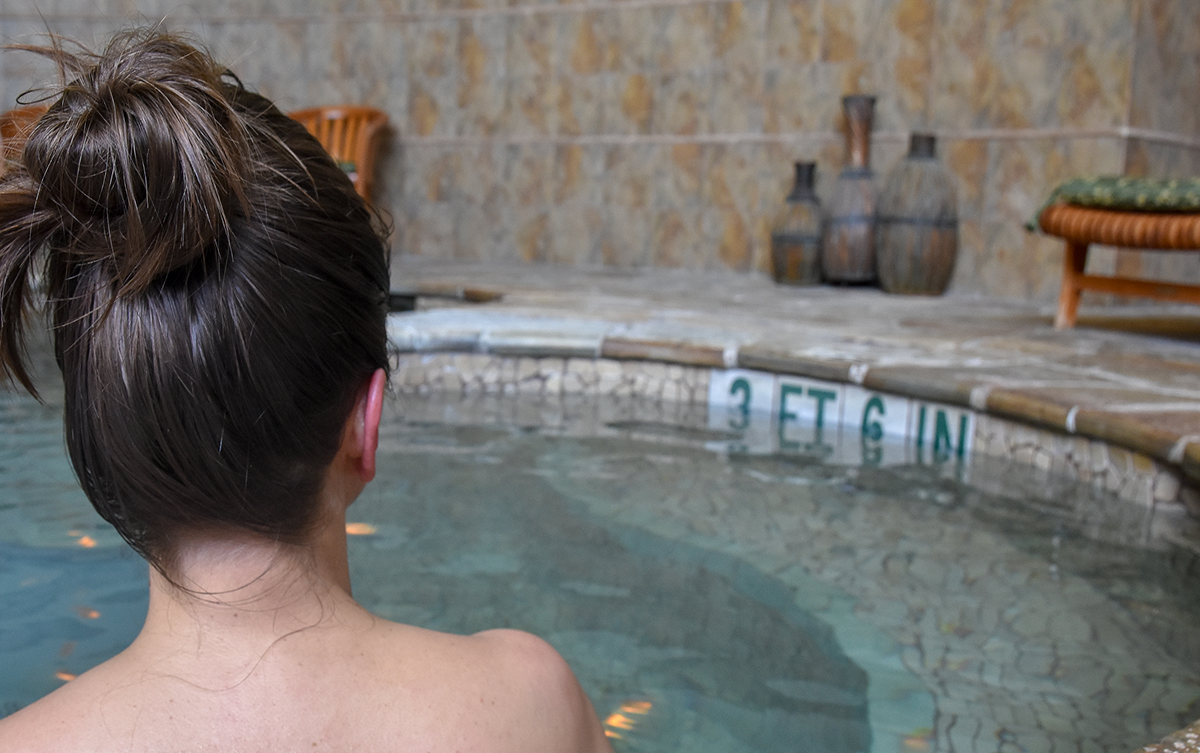
The Spas of America named The Skana Spa at Turning Stone in Oneida, N.Y., the fifth best spa in the world in 2017. The spa, which takes its name from the Oneida word for “peace,” offers a full-service experience for each guest. Photo by Marita Pérez Díaz.
I chose the signature Skana massage because it uses my people’s traditional Haudenosaunee white pine combined with sage oil. My fatigued mind longed for some peace. But I struggled to relax on the massage table. I decided to take myself through a meditation to relax. In my mind, I ran every color of the rainbow through my body. One by one, I imagined a ring of color, like a hula hoop, starting at my feet and running up my body. The light inside the ring traveled through my body and filled every muscle and cell with the colored light. When I arrived at the color purple, I began to feel strong, tall, and proud. I felt my energy expand beyond the walls of the room. Purple and white have been associated with my people for more than a thousand years because of our use of wampum — traditional beads fashioned from white and purple quahaug shells — in our ceremonies and as a form of communication. Wampum have been used to make treaty agreement belts with the Dutch, French, English and later, the Americans. We also used wampum belts to memorialize important aspects of our history, just as a book would. Each wampum bead represents an entire story that is memorized by the keeper of these belts. Wampum is held sacred by my people, and our stories about it go all the way back to the formation of our confederacy. Oddly enough, purple and white are the two top chakras in the body, associated with insight and connection to the universe. Wrapped in the colors of purple and then white, I felt like royalty and a deep sense of being centered. I fell into a tranquil calm. In the background, I heard the sounds of nature and Indigenous flutes. I hear geese in the music and was reminded of my people’s Creation Story. Geese helped the first human, a pregnant woman, Sky Woman, to enter into this new world.
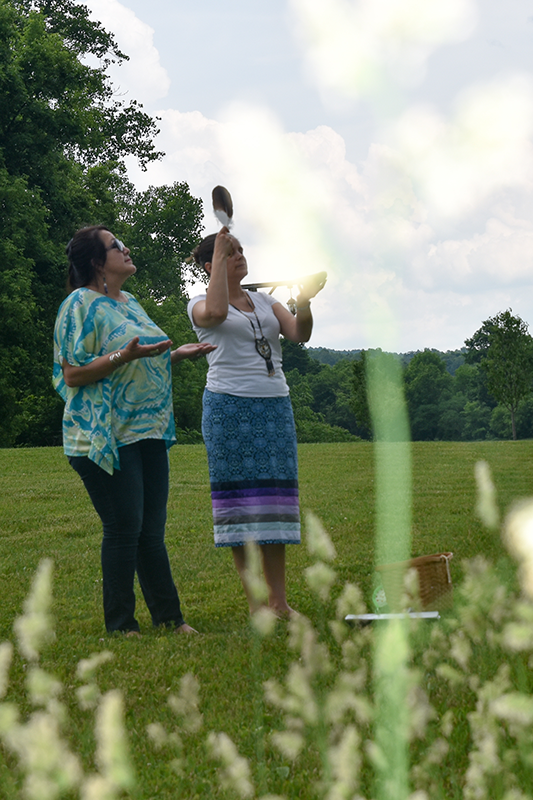
After relaxing at Skana Spa, Michelle Schenandoah’s mother sends her off at Wolf Oak Acres in Oneida, N.Y., before beginning her journey. The Oneida Nation is part of the Haudenosaunee Confederacy, which is also made up by the Mohawks, Onondagas, Cayugas, and Senecas. Photo by Marita Pérez Díaz.
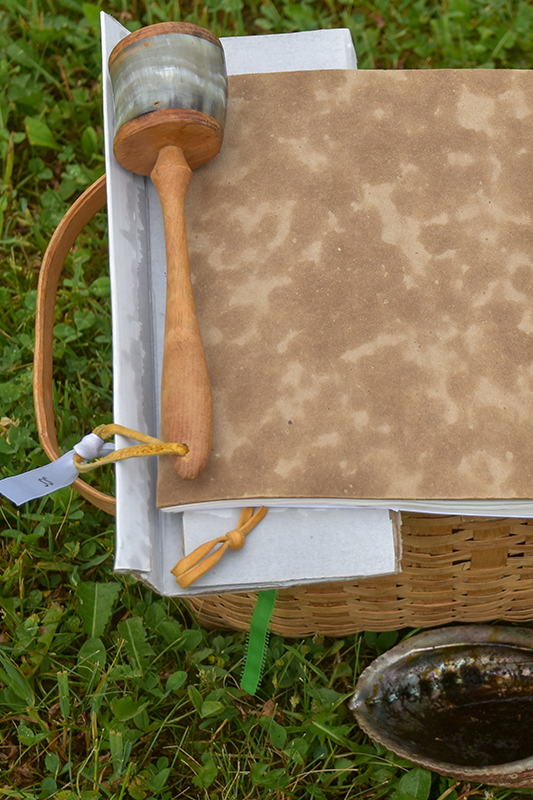
For her journey, Michelle Schenandoah brought a basket filled with tobacco, an eagle feather, a bullhorn rattle, an abalone shell, sage, corn, and wampum to offer thanks to the natural world and the Creator of life. Photo by Marita Pérez Díaz.
I rose and prepared for my journey westward to the lands of the Seneca people. As I drove, I looked out the window and saw miles and miles of undulating green hills covered with sprinklings of purple and white flowers. I also saw what lay beneath — the rich culture of my people and the energy residing within the ground that rises into the air. I saw our vast cornfields planted into dirt mounds, our longhouses built of elm bark and elongated to house multiple extended families who belonged to the same maternal line. I saw the bustling activity of a community of people working and playing together. I saw women, people outside tending to the fields, and elders telling stories to the children to keep our culture alive. Then an old factory from some era of “progress” that failed to last appeared outside my window and before too long a strip mall attempting to cling to life. These relics of progress reminded me of my ancestors willingness to share their way of life. For example, founding father Benjamin Franklin and suffragist and abolitionist Matilda Joslyn Gage, two iconic figures of change in U.S. history, both spent extensive time with and studied the ways of my people. We inspired the actions they took to create democracy — the U.S. Constitution, the three branches of government, the power to veto, and women’s rights to the American people — based on our form of government and way of life.
The pull of our female leadership brought me to Ganondagan, the largest of four major historic Seneca villages destroyed by the French in 1687. It housed 4,000 people in 150 longhouses for 350 years, with massive corn fields, and bark silos that stored corn for emergencies. The French destroyed more than 1.2 million bushels of stored and standing corn among the four villages. Ganondagan had a reputation for being a peacekeeping village, as it held most of the civil leadership, whereas the more western villages at the outskirts of the confederacy served as a defense. Today it covers 500 acres and miles of trails. On the June morning of my visit, a gray clouded dome stretched across the sky from the eastern horizon to the west. The air felt like a heavy, cold blanket. My damp hair wrapped around me, adding a layer of frigid wetness. I stepped foot onto the lands, a place where the Seneca Nation once thrived. Among them was a woman who received the name and title of Jigonsaseh. Her name is often referred to as the Peace Queen in textbooks. The first Jigonsaseh spoken about in the formation of our confederacy is called the Mother of Nations among the Haudenosaunee. She was the first person to accept a message of peace from a spiritual messenger called the Peacemaker, who traveled across Lake Ontario in a canoe made of stone. A woman among many women leaders, who owned vast fields of corn, Jigonsaseh wielded great power and encouraged a blood war waged between nations. She tried to kill the Peacemaker, and to her surprise, was unsuccessful. This made her stop and listen to his words. His message forged the creation of a great confederacy of five nations being united under a government and spiritual way of life grounded in peace and democracy. The same democracy and governmental system the colonial states replicated to form the United States.
I came to Ganondagan to pay honor to Jigonsaseh and the women who took her name and leadership title after her. Visiting the lands to pay my respect and offer prayers, I help to keep her story alive. I took my sandals off and walked across the cold, wet grass and small broken bits of pine cone from the white pine tree planted at the peak of the luscious, green park. The moment I saw the soft white pine needles that bounced with the cool breeze, calm washed over my entire body, through my feet, and into the ground. I placed both my hands onto the pine tree, closed my eyes, and saw them, the four sacred white roots of peace we are told travel under the ground to every corner of the world. With Jigonsaseh’s help, the once warring nations accepted the Peacemaker’s message of peace, and the Haudenosaunee Confederacy formed. My ancestors buried their weapons of war under the white pine tree, a symbol and promise to forever live in peace and democracy.
I released the tree, walked into the open field, and sat on the ground. I closed my eyes and breathed in the cold, fresh air, washed by the rain before I arrived. Tears began to fall from the corners of my eyes as I thought about this sacred land and felt gratitude for the opportunity to tell its story. I turned my palms to the sky and rested them on my knees. I asked for guidance from our people who lived before us, the ones who carried this message of peace for hundreds of years, my ancestors. I asked for the great peace to be returned to the lands once again, and for all those whose families traveled across the oceans to live here, that they too, will hear this message of peace, once again, as their ancestors did.
I wonder how many other inaccurate signs dot the state of New York.
Clips of grass and specs of dirt covered my feet. The cold I felt earlier evaporated. I walked to the edge of the tall grasses left uncut and followed it to the replication of a bark longhouse set up for the park’s visitors. Outside the longhouse, a small vegetable garden featured traditional mounds of planted corn, beans, and squash. Our three sacred sisters, as we call them. Scientists marvel at their natural chemistry and how they help each other grow, keeping away pests and weeds. I sat on the wooden bench alongside the fire pit outside the longhouse and overheard conversations from the tourists inside as they tried to imagine a world in which my people once lived.
Their comments frustrated me, and I decided to leave, seeking to shift my energy and my own thinking. I entered the new, multi-million dollar Seneca Art and Culture Center featuring more than 2,000 years of Haudenosaunee cultural arts, history, and presentations of the modern day lives of our people by providing interactive experiences with our culture — from white-corn husking bees to dance performances by our people, and discussions about our culture. Inside I found friends who work at Ganondagan. They prepared for the arrival of our notable Mohawk Bear Clan Mother, Louise McDonald, and Sally Roesch Wagner, founder of the Matilda Joslyn Gage Center for Social Justice. These two friends shared a conversation about the Haudenosaunee influence on the suffragettes over tea and white cornmeal cookies in front of an audience of about 50, mostly white women. Wagner talked about the foremothers of white women in this country, like Gage, who learned first-hand about gender equality from Haudenosaunee women. Roesch said these women fought to live free from the patriarchal notion that women were the progenitors of original sin. The suffragists fought for full self-autonomy, something they saw Haudenosaunee women possessed. Gage wrote about these influential experiences, which Wagner explored in her book, Sisters in Spirit. McDonald said Haudenosaunee women owned, and still own, our lands, our homes, our children, and our bodies, controlled the economies of our nations, and chose our nation’s leaders. But it was white settlers, even white women, who participated in the forced assimilation of our people into a white culture and religion that stripped us of our culture, our land, and our dignity. They finished by taking a tour together through the Seneca Arts Cultural Center’s new exhibit, Hodinöhsö:ni’ Women: From the Time of Creation.
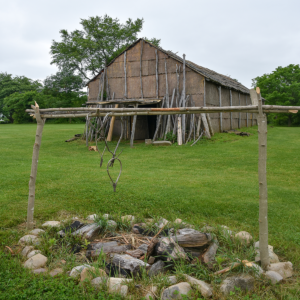
This longhouse is part of the new Seneca Art and Culture Center in Victor, N.Y. It features more than 2,000 years of Haudenosaunee art and history. Visitors can participate in interactive exhibits, watch Haudenosaunee dance performances, and listen to cultural discussions. Photo by Marita Pérez Díaz.
I met my friend Ron Garrow, executive director of the Native American Cultural Center in Rochester, at the talk. He offered to take me to the Durand Eastman Park, where he’s working with the city of Rochester to mark the Peacemaker’s journey across Lake Ontario and the message he brought to the Haudenosaunee that came to impact the world. As I planned my outing the night before, I was unsure if there was an actual area where it’s said the Peacemaker landed. I pulled out my laptop, sat in bed, and googled, “Peacemaker Lake Ontario.” One of the results was, “Peacemaker Brewing Company,” in Canandaigua. I wondered if Ron and other members of my community knew that one of the founders of the Iroquois Confederacy, a man whose personal name we use only in special ceremonies out of respect, was being used to sell beer.
Leaving Ganondagan, I followed Ron to his favorite beach, which sat tucked away behind rows of oaks, elms, and maple trees. Just outside the entryway to the narrow beach, I saw a huge peace sign made of small white rocks. Inside, Ron and I both took our shoes off and placed our people’s sacred tobacco into the palm of our left hand, a place that connects to our heart energy. The sand felt soft, smooth, and cold. The sun returned to the sky and shined across the water and into our eyes. We took a few steps up to our ankles into the frigid, calm water of Ontario. I said a prayer aloud and thanked the Creator for the day we had been given, Mother Earth for giving us a place to live, the waters for supporting life, the plants and animals, our ancestors, and those yet unborn. I thanked the Peacemaker and the message he brought. In silence, we then each paid our respect to the Peacemaker in our own way. Around us, the calm waters shifted into rapid, rough waves that splashed and soaked my skirt and shirt. Ron laughed and said, “look.” The waters to our left and right remained still, calm, crystal clear, and yet rough waves, washing up to my knees, filled the area surrounding the small spot where we stood. We waited and then stepped out onto the bank. Ron gave me a hug and left to watch the Rochester Night Hawks lacrosse game, a sacred practice of my people that has become the fastest growing sport around the world. I lingered, sitting on a fallen tree, to watch the sunset.
Driving away from the park through the city’s layers of concrete highways, I wondered how many people of Rochester know they live in between these sacred spaces — the homelands of Jigonsaseh and the Peacemaker’s landing. The same space giving the United States its foundation of democracy, its constitution, its three branches of government, and even a policy of immigration. But the primary element left out of all the ideas taken from my people — the role and authority of women in government and the economy. And, I’d even say, they left out spirituality too. It was Haudenosaunee women, our clan mothers, who have always held the absolute power to remove a chief who became self-interested and who failed to listen to the people. A chief serves as only the eyes and ears of the people, not himself, or a select few. I imagined what the country would be like if President Donald Trump had a clan mother to whom he answered.
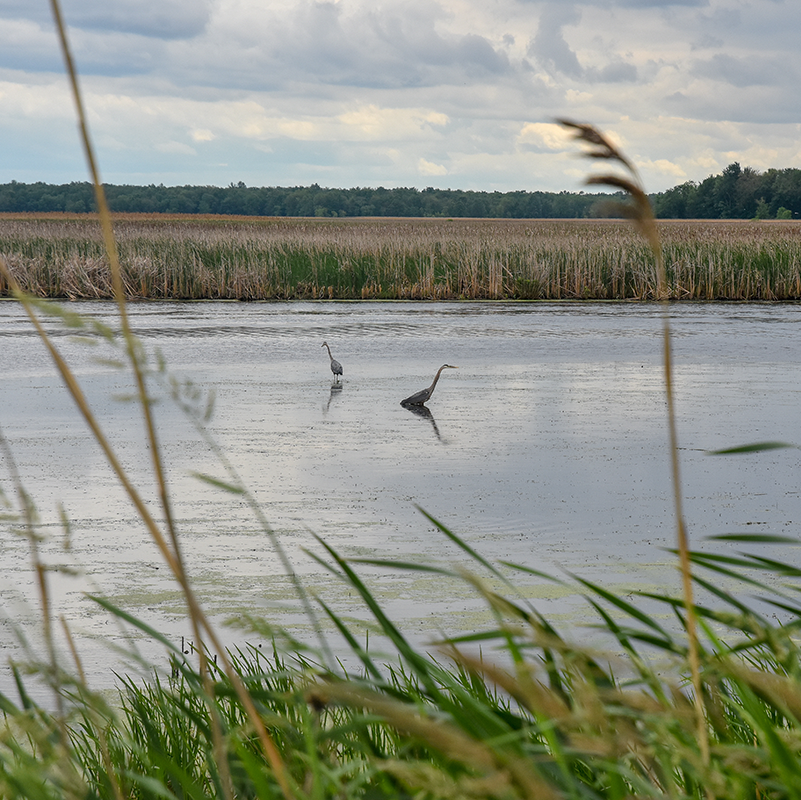
Located 35 miles west of Syracuse, the Montezuma National Wildlife Refuge was founded in 1938 as a refuge and breeding ground for migratory birds and other wildlife. There are six active bald eagle nests at Montezuma, and 43 species of mammals have been reported as having used the lands for refuge. Photo by Marita Pérez Díaz.
I drove on to the town of Canandaigua. When I made my itinerary, I picked that town because all I wanted was to wake up alongside Canandaigua Lake, which sits centered in the Finger Lakes region, an area known mostly for its wine vineyards, farm-to-table restaurants, and beautiful vistas of the lakes that glaciers created long ago. My people say the Creator scratched his hand into the Earth to make these lakes for my people to live by, and on a map, they appear just like that — as if scratched into the land. Then, as I pulled into Canandaigua, it hit me: “Ah, the Canandaigua Treaty. Yeah, that’s it,” I thought. The United States signed the treaty after trying to eradicate my people from the lands they came to call New York. During the attempted genocide known as the Clinton-Sullivan Campaign, a smaller war in the Revolutionary War, President George Washington ordered all Haudenosaunee villages burned to the ground and the people killed so the lands could be settled by the colonies. The U.S. government gave every soldier who fought in the war land stolen from our territories. Driving across the state, I see these tracts of lands given Greek and Roman names by the invading settler known as New York State. Thanks to the cicadas that only come out every 17 years, we survived the following summer because the cicadas came and served as our food source. This summer they returned again, and my people rejoice, giving great thanks to them for saving us. Since we did not die in the war as planned, the government agreed to acknowledge us and signed the Canandaigua treaty. Every year, my people hold a treaty commemoration in Canandaigua to show we are still here — sovereign nations, just like the U.S.
Outside my hotel door that faced the lake, I listened to the pumping bass of a wedding reception. Frank Sinatra’s “New York, New York” blared into the chilled darkness alongside the lake, and I took one last look at Facebook before calling it a night. My alarm went off at 6 a.m., and I felt my immediate reaction, a grumbling mind. But I reminded myself I took this trip to enter into a spiritual place of feeling connected, and to get out of my mental negativity. I kicked my legs up and rolled out of bed. I put on a ribbon skirt, grabbed my basket, and I walked outside to the water. I took out some sage and placed it in my abalone shell. I lit the sage and with my eagle feather, smudged the smoke over the top of my head and down my body. I lifted the sage into the air toward the sun, to the east. I turned to my left, counterclockwise, to honor the direction of life, the direction the Earth rotates, and lifted the shell toward to the north. I turned again and honored the west, and turned to honor the south. I gently waved the feather toward the ground to honor Mother Earth and then up across the sky to honor all that exists in the vast universe.
“Yaw^ko Sankwaidezu,” I said, giving thanks the Creator of life. “I give thanks for this day and for all of life.” I then offered tobacco to the water in peace and thanked the water for giving us life. As women, we are told that we are the keepers of water. All of life, and all babies are born in water, and as life givers, it is our responsibility to protect the water for all future generations. I ask for the water to always be pure.
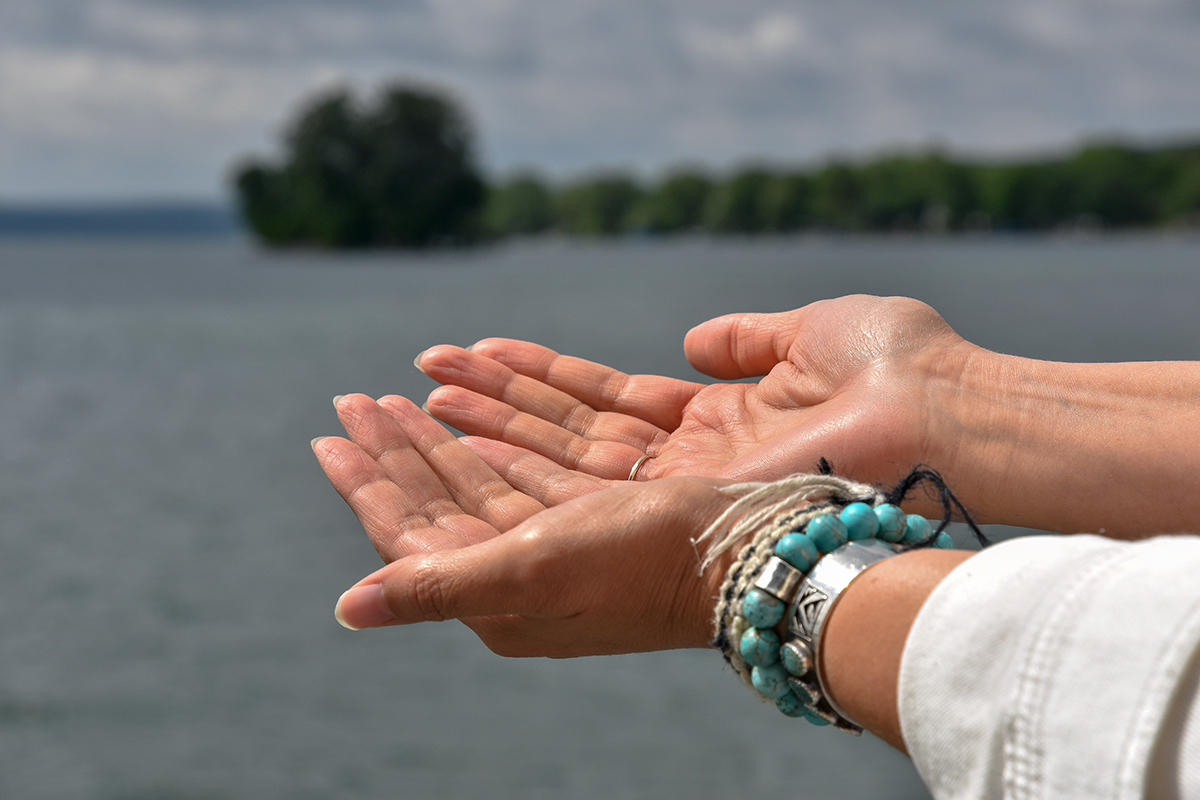
Michelle Schenandoah gives thanks to the Creator of life while looking out on Canandaigua Lake, the fourth largest of New York’s Finger Lakes. Located in Canandaigua, N.Y., the lake gets its name from a Seneca word that translates to “the chosen place.” Photo by Marita Pérez Díaz.
Taking some deep breaths, I turned my palms to the sky, and thanked all that is for the moment I was given, another day of life. I thanked the plants, the animals, the medicine plants keeping us healthy, and the water. I asked for love to be sent to those in need and food given to those who are hungry. I acknowledged those yet unborn, our ancestors, and that we, as humans, live so future generations have a better world to live in than we have. I sat and listened.
After a quiet moment, I stood and sang a traditional women’s song to honor the four directions, all of life, and all that watches over us. With each verse, again, I turned into the directions of the east, the north, the west, and then to the south. Then I sat again in silence. I do not know if I sat there for 10 minutes or an hour. I breathed in life and said thank you again in my language on my exhale. When I arrived at a feeling of contentment inside, I opened my eyes.
This accident became a gift. It stopped me from devoting endless hours in my day rehashing memories or worrying about the next steps in my life.
A few puffy clouds hung in the blue sky. The water lapped with the wind, and the seagulls flew through the sky laughing at each other. Fish splashed as they jumped out of the water and a duck swam up, looked at me, and swam away. Small summer cabins dotted the edge of the lake. I hadn’t quite noticed any of this before. This feeling of presence arrived. I knew this feeling from the concussion I experienced a few years before, a trauma erasing my ability to access my memory, or to analyze and think about the future. I fought it for months, but one day I realized, I’m present. Many people take years of meditative practice to arrive to this state. This accident became a gift. It stopped me from devoting endless hours in my day rehashing memories or worrying about the next steps in my life. A car accident and brain injury knocked my life off track and brought me into alignment with myself. I was present — I was in the now. This feeling stayed with me for nearly two years. It was exhilarating. I enjoyed my life and the moments that filled it so much more because those moments became all I possessed.
As I stood at the lake’s edge, a cool breeze traveled across my skin, moving wisps of my hair onto my face. I felt renewed inside. I felt in my body and not just my head. Spending time in gratitude brings me back to this place of spiritual presence. My people have known that giving thanks to life and the universe brings us closer to our spiritual connection to life. My people say we have the responsibility to give thanks for every element of life, even those we don’t see. Every one of these elements make it possible for humans to live on our Mother Earth. It is said when humans forget to acknowledge and give gratitude to life, it will go away. We have the responsibility to act on behalf of those not born yet — seven generations into the future.
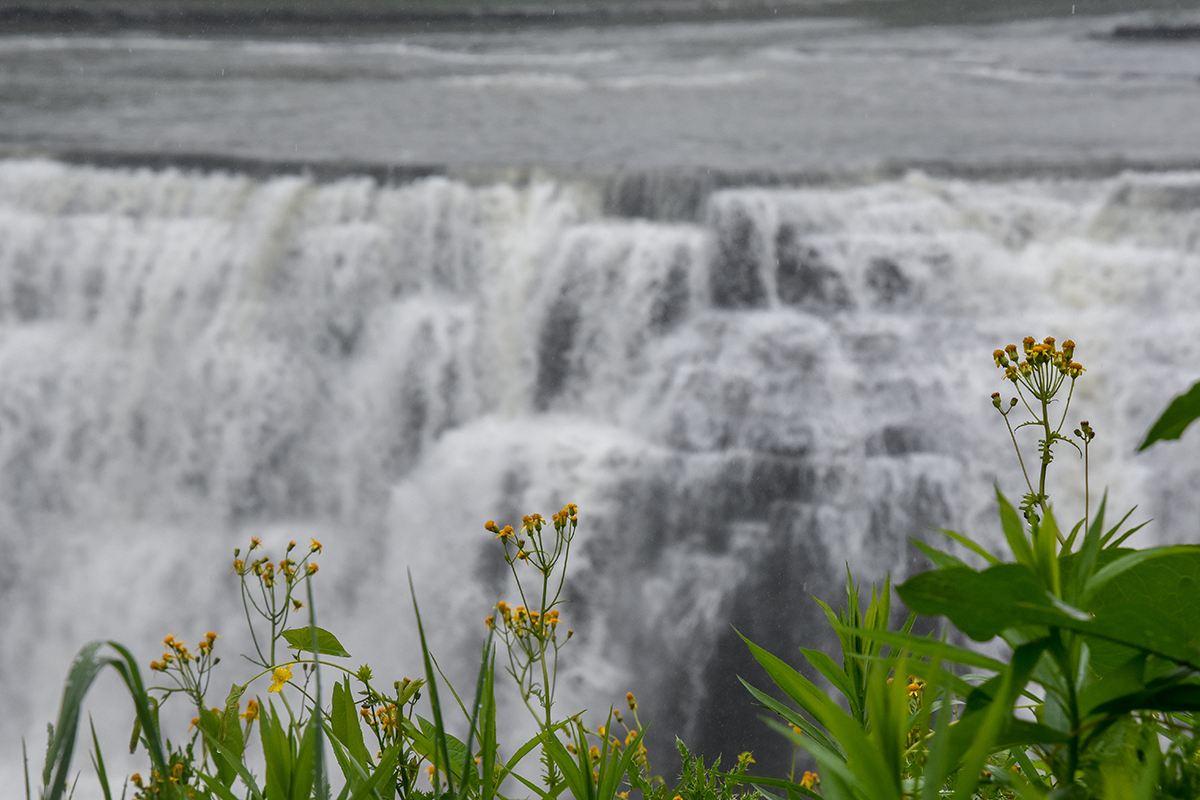
Spanning over 14,000 acres and across two counties, Letchworth State Park in Castile, N.Y., is an important piece of land to the Seneca people, who called it Sehgahunda, or the Vale of Three Falls. The Senecas built villages on land that is now part of the park. Photo by Marita Pérez Díaz.
The next day I set out for Letchworth State Park, which is called the “Grand Canyon of the East” and voted by USA Today readers as the best state park in the United States. But those accolades aren’t what brought me there. I asked a few Senecas about any stories their people have about this place. They knew these lands, their Seneca territories, but they mostly spoke about Mary Jemison, the white woman who was captured and adopted as a Seneca and later bestowed with the title of clan mother, an honor generally reserved for the blood descendent of a previous clan mother. But I really didn’t know why I felt compelled to travel here. I wanted the chance to see the massive waterfalls and canyon in the park, but I knew something else waited there for me to gain. Adoption among the Haudenosaunee was a common practice. Mary’s story reminded me about our principles as Haudenosaunee, that anyone seeking shelter under the Tree of Peace can do so by adopting our peaceful way of life. Just like the Tuscarora nation brought into the Haudenosaunee Confederacy in the early 1700s. This process is called “adding to the rafters,” that is, making our longhouse bigger for more to live with us, in peace. Today, refugees from around the world seek sanctuary in cities across upstate New York that have offered assistance and housing. Several years ago, I watched a performance in Syracuse about Congolese refugees who shared their personal stories, and they asked the question, “Why Syracuse?” Sitting in the audience, I felt the immediate response — it’s their ancestors helping them and leading them along the four sacred white roots to the heart of the Haudenosaunee Confederacy to find peace from the warring countries.
Again, as I arrived at Letchworth, the rain followed. Small gray clouds hugged the ridges of the canyon peaks. It continued to pour and drizzle. Smaller canyons roared with the sounds of rushing water making its way to lower grounds. To connect to this energy, I walked barefoot through the forests. After an hour, soaked, I decided to return to my car and began the trip home to Syracuse, the capital of the Haudenosaunee Confederacy. As I drove across the thruway, where my people once ran across the trails now covered by asphalt, I looked out the window onto the rolling hills covered in pines, birch, elm, and the leader of the trees, the maple. Feeling the spaces where we have lived for thousands of years, I felt a familiar, deep sensation of my spirit being drawn to the lands and to my culture. Always present, always a force that draws me close, like gravity.
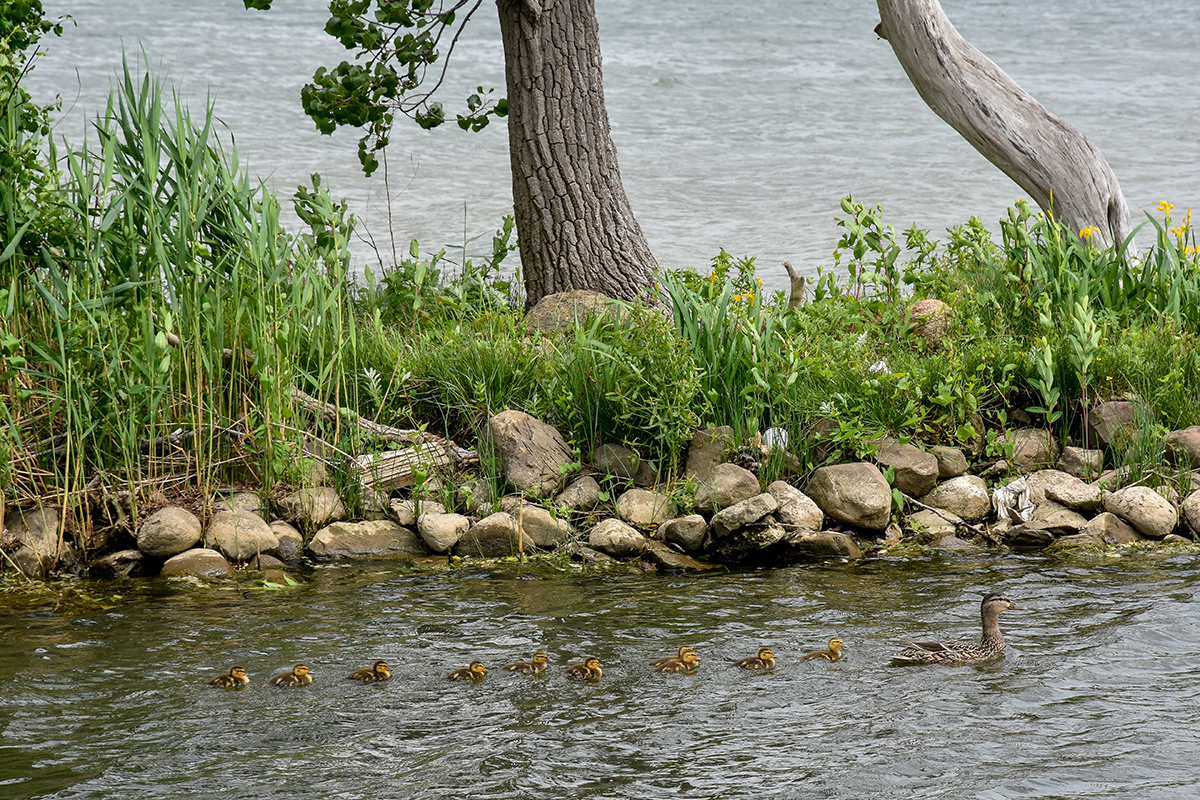
Ducklings follow their mother in a line on Onondaga Lake near Syracuse, N.Y. Considered to be sacred water by the Onondaga Nation, the lake often tops the list of most polluted lakes in the country. Photo by Marita Pérez Díaz.
I looked out my car window and remembered that June is the time of babies for the animals in the Northeast. I saw several deer at the edge of the woods. The Oneida name for deer is, oskanu·tú. We call them leader of the animals, and it serves as the source for my last name. Alongside the thruway, geese tried to keep their goslings protected from the cars and trucks that rushed by only a few feet from their springtime birthing places. I thought about their lives, and then I thought about my own grandchildren and their grandchildren and wondered what their future will hold. The goslings and the rushing cars signal to me that my work remains unfinished. As Indigenous people, we are praying, speaking to, and asking humankind to change the way we live. Nature serves as the mirror to the lives we lead as human beings and to the future we create for those yet unborn. I continued to look out the window, searching for another deer or a wandering gosling. As I moved closer to home, work and to-do lists returned to me. I also remembered that mental note I made to correct the historical marker outside the rest stop at Canastota. The exit for Syracuse appeared, and I wondered how many other inaccurate signs dot the state of New York.
Banner photo by Marita Pérez Díaz.



